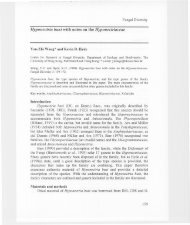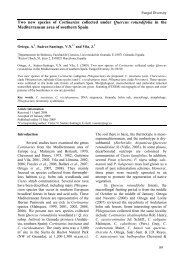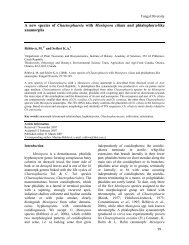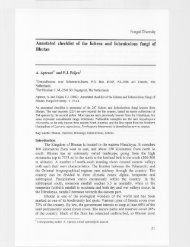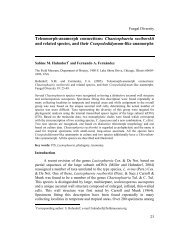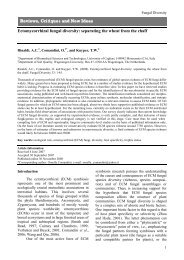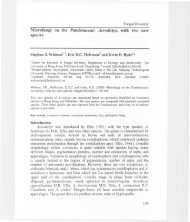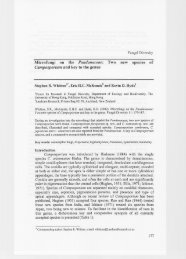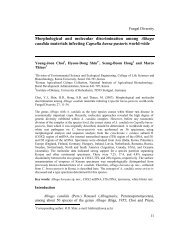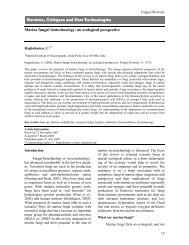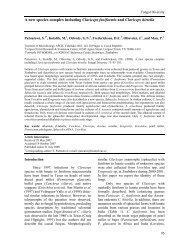A nomenclatural revision of the genus Alnicola - Fungal diversity
A nomenclatural revision of the genus Alnicola - Fungal diversity
A nomenclatural revision of the genus Alnicola - Fungal diversity
You also want an ePaper? Increase the reach of your titles
YUMPU automatically turns print PDFs into web optimized ePapers that Google loves.
<strong>Fungal</strong> Diversity<br />
N. macrospora J.E. Lange. Agaricus salicis has been splitted by Orton (1984),<br />
<strong>the</strong> holotype <strong>of</strong> A. salicis being redescribed more correctly by Reid (1984:<br />
203). see under MACROSPORA.<br />
Accepted name: A. macrospora J.E. Lange → J. Favre.<br />
scolecina<br />
Status: valid, not typified. Lectotype (automatic, designed here): original plate by E.<br />
Fries (n° 665, S), published by Fries (1877-1884, pl. 124-1), mentioned in <strong>the</strong> protolog. Host:<br />
Alnus sp. (probably A. incana).<br />
Basionym: Agaricus scolecinus Fr., Epicr.: 194 (1838).<br />
≡ Naucoria scolecina (Fr.) Quél., Champ. Jura Vosges: 438 (1875).<br />
≡ Hylophila scolecina (Fr.) Quél., Ench. Fung.: 101 (1886).<br />
≡ Hylophila sideroides var. scolecina (Fr.) Quél., Fl. Mycol.: 87 (1888).<br />
≡ <strong>Alnicola</strong> scolecina (Fr.) Romagn., Bull. Soc. mycol. France 58 (4): 122 (1942).<br />
Notes: this taxon is interpreted in modern literature following Lange<br />
(1938) and Romagnesi (1942), as a bitter, not striate species, <strong>of</strong>ten growing<br />
cespitose. This is certainly not in conformity with Fries’ definition (Fries,<br />
1838), which concerns an originally very pale and glabrous species. Kühner<br />
(1980: 933, 967) suggested that A. scolecina ss. Fries might be identical to A.<br />
inculta (Peck) Singer (= A. alnetorum, inval.), what is acceptable according to<br />
Fries’ (1877-1884, pl. 124-1) plate; moreover Fries specifies (loc. cit.: 22) that<br />
this plate represents a more coloured forma. At <strong>the</strong> opposite Singer (1977:<br />
210), on <strong>the</strong> basis <strong>of</strong> personal collections near Femsjö, interprets A. scolecina<br />
as a small-spored species with acute cystidia. This taxon should be redefined<br />
and neotypified after a complete <strong>revision</strong> <strong>of</strong> Scandinavian species <strong>of</strong> <strong>Alnicola</strong>,<br />
and if revealed to be identical to A. inculta, asked for a rejection in favour <strong>of</strong><br />
<strong>the</strong> last.<br />
Provisionally Lange’s (1938, 1939) interpretation (certainly inadequate<br />
but usual) is adopted by Moreau and Vidonne (2005).<br />
Accepted name: <strong>Alnicola</strong> scolecina (Fr.) Romagn.<br />
silvae-novae<br />
Status: valid. Holotype (visited): UK, Denny, Hants, sept.1982 (K). Host: Alnus sp.<br />
Basionym: Naucoria silvae-novae D.A. Reid, Trans. Brit. mycol. Soc. 82 (2): 206<br />
(1984).<br />
≡ <strong>Alnicola</strong> silvae-novae (D.A. Reid) Courtec., Doc. mycol. 16 (61): 48 (1985).<br />
Notes: <strong>the</strong> bispory, probably accidental (and only partial) mentioned by<br />
Reid (1984) as a specific character <strong>of</strong> A. silvae-novae, cannot be considered as<br />
such, since it can occur potentially in all 4-spored species in <strong>Alnicola</strong>. By all<br />
o<strong>the</strong>r features this taxon is referable to A. subconspersa (because <strong>of</strong> veil and<br />
ground colour).<br />
Accepted name: <strong>Alnicola</strong> silvae-novae (D.A. Reid) Courtec. (if different<br />
from A. subconspersa).<br />
145



